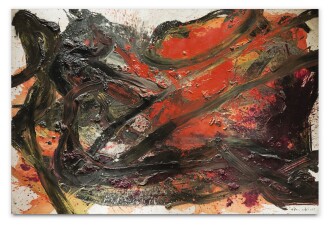Works by Kazuo Shiraga at Sotheby's
Kazuo Shiraga Biography
Kazuo Shiraga, known for his dynamic ‘performance paintings’, was a pivotal member of the remarkable avant-garde art collective Gutai Bijutsu Kyokai. As Japan’s first radical postwar artistic movement, the Gutai group rejected tradition in favor of performative expression and physical engagement with a wide variety of techniques and materials. Shiraga, whose spontaneous gestural works are notable for their visceral energy, once stated: “I want to paint as though rushing around a battlefield, exerting myself to collapse from exhaustion.” Shiraga’s innovative techniques would inspire European and American artists like Yves Klein and Georges Mathieu, and anticipate Arte Povera, Fluxus and conceptual art.
Born in 1924 in Amagasaki, Japan, Shiraga studied at the Kyoto City University of Arts. Disillusioned with traditional Japanese painting, Shiraga co-founded Zero Society, an avant-garde conceptual group which merged with Gutai in 1955. Shiraga became one of the group's most prominent members, creating seminal works such as Challenging Mud (1955), in which he used his whole body to wrestle through a mixture of clay and cement to the point of exhaustion. In 1956, he embarked on his iconic ‘Performance Paintings’, for which he would suspend himself over his canvases, swinging back and forth to create marks with his feet before an audience. Shiraga would continue to explore the relationship between the body and artistic media throughout his long career. He died in 2008 at the age of 83.
Gutai went largely unappreciated in the States during Shiraga’s lifetime; however, in 2013, the Guggenheim mounted a definitive exhibition (Gutai: Splendid Playground), bringing his work to the attention of American audiences. Today, Shiraga’s paintings are housed in the permanent collections of the National Museum of Modern Art and the Hara Museum of Contemporary Art in Tokyo; the Hiroshima City Museum of Art; Dallas Museum of Art; Walker Art Center in Minneapolis; and Centre Pompidou in Paris.
Read Less











